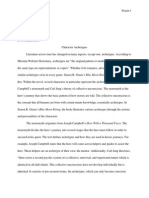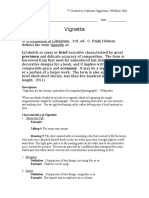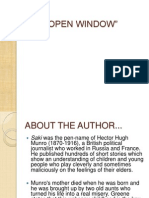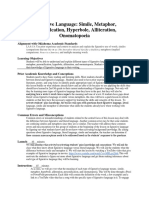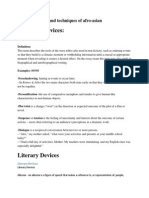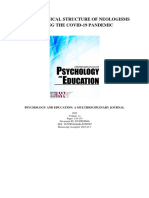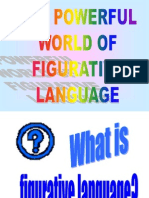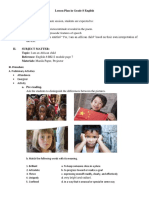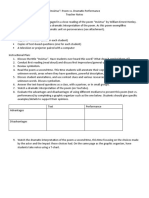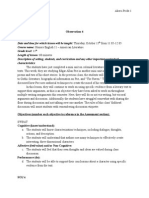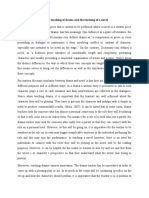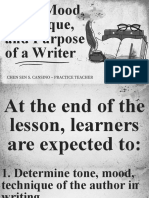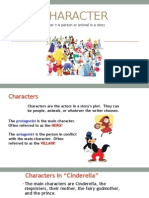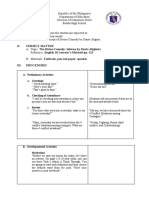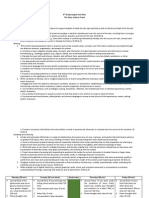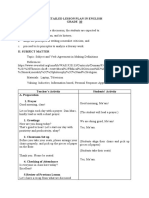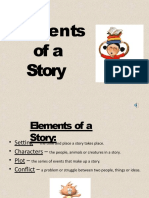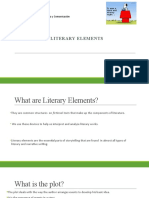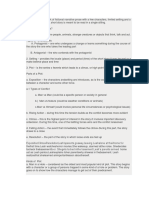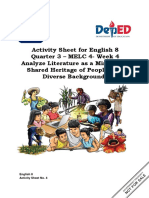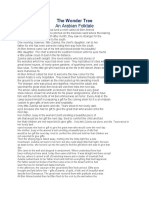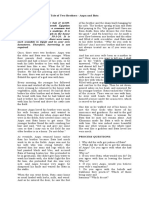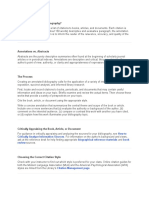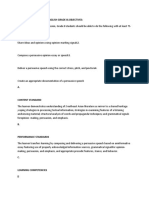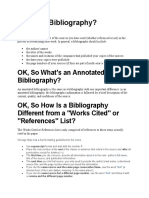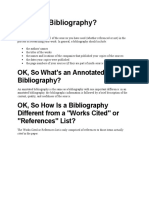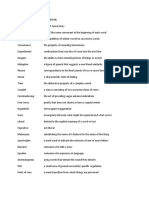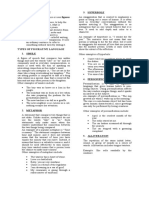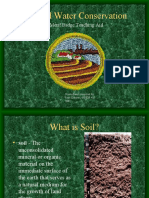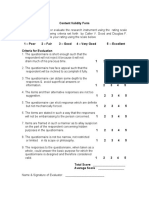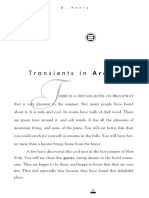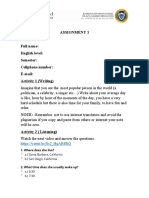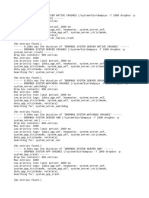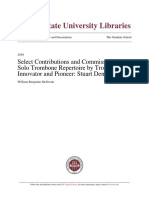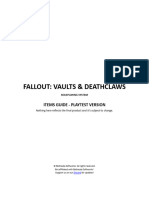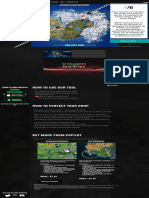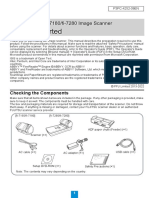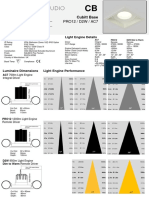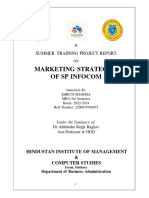A Short Story Elements
A Short Story Elements
Uploaded by
Salvador Lawrence TogoresCopyright:
Available Formats
A Short Story Elements
A Short Story Elements
Uploaded by
Salvador Lawrence TogoresOriginal Description:
Copyright
Available Formats
Share this document
Did you find this document useful?
Is this content inappropriate?
Copyright:
Available Formats
A Short Story Elements
A Short Story Elements
Uploaded by
Salvador Lawrence TogoresCopyright:
Available Formats
A short story is a work of short, narrative prose that is usually centered around one single event.
It is
limited in scope and has an introduction, body and conclusion.
Elements of a short story
1. Setting: Where and when is the story set? Setting represents both the physical location but also the
time (i.e. past, present, future) and the social and cultural conditions in which the characters exist.
2. Character: A person or animal or really anything personified. There can be one main character or
many, and often there are secondary characters, but not always.
PROTAGONIST. The HERO or the main character is the character you are hoping will succeed, defeat the
villain, and be happy.
ANTAGONIST. The VILLAIN, is the character who tries to prevent the HERO from succeeding or being
happy.
3. Plot: The events that happen in a story are called the plot. In a plot you typically find an introduction,
rising action, a climax, the falling action, and a resolution. Plot is often represented as an arc. To learn
about plot in detail, read the article: “What is a Plot.”
1. Beginning or Exposition-this is when characters and problems are introduced to the reader.
Example: Romeo and Juliet's families are enemies, but Romeo and Juliet meet at a party and like each
other.
2. Rising Action-this is where the problem and characters are developed through a series of actions
that builds to the . . .
Example: Romeo visits Juliet on a balcony one night, and then she sends a message to him through her
nurse. They meet and secretly wed without their families' knowledge. Romeo kills Juliet's cousin Tybalt,
and he is exiled. Juliet's father orders her to marry someone else. Juliet fakes her death, sending a
message to Romeo to let him know, but he hears of her death and doesn't get the message.
3. Climax-this is where the problem (or conflict) is resolved in one way or another. The climax is
often called the "turning point" in a story.
Example: Romeo kills himself, and Juliet wakes from her sleep, sees him, and kills herself.
4. Falling Action or Denoument-this is where the reader learns what happens as a result of the
climax-or the way in which the problem was solved.
Example: The two families mourn Romeo and Juliet.
5. Resolution-where the entire plot is wrapped up and there is a sense of closure for the reader.
Example: Romeo and Juliet's deaths have ended their families' feud and there is peace in Verona.
Conflict: Every story must have a conflict, i.e. a challenge or problem around which the story is based.
Without conflict, the story will have no purpose or trajectory.
4. Theme: Idea, belief, moral, lesson or insight. It’s the central argument that the author is trying to
make the reader understand. The theme is the “why” of the story.
You might also like
- Archetype Essay FinalDocument7 pagesArchetype Essay Finalapi-273609737100% (1)
- Lesson Plan - Short Story Like The SunDocument2 pagesLesson Plan - Short Story Like The Sunapi-272982133No ratings yet
- Vignette HandoutDocument9 pagesVignette HandoutsherinrachiNo ratings yet
- Differentiated LessonDocument3 pagesDifferentiated Lessonlindsay_115No ratings yet
- The Open WindowDocument20 pagesThe Open WindowLauri Sierra100% (4)
- Choral and Rock-Out - Ted Huggens Wind Ensemble PDFDocument28 pagesChoral and Rock-Out - Ted Huggens Wind Ensemble PDFErcole Lattari0% (1)
- Figurative Language Lesson PlanDocument5 pagesFigurative Language Lesson PlanRoel Chul Su BositoNo ratings yet
- Version 2 of Curriculum MapDocument7 pagesVersion 2 of Curriculum Mapjmclean3No ratings yet
- Lesson Plan in EnglishDocument4 pagesLesson Plan in EnglishRyderchange Colegado Etulle100% (1)
- Literary Devices and Techniques of AfroDocument2 pagesLiterary Devices and Techniques of AfroMary Ann Santos0% (1)
- The Short Story: RationaleDocument23 pagesThe Short Story: RationalewoodycoquinNo ratings yet
- Anne Frank Blooms Taxonomy For Final ProjectDocument2 pagesAnne Frank Blooms Taxonomy For Final Projectapi-252664461No ratings yet
- Intro Lesson Plan To Genre Analysis UnitDocument5 pagesIntro Lesson Plan To Genre Analysis UnitDanahNo ratings yet
- Morphological Structure of Neologisms During The Covid-19 PandemicDocument17 pagesMorphological Structure of Neologisms During The Covid-19 PandemicPsychology and Education: A Multidisciplinary JournalNo ratings yet
- eNGLISH lESSON pLANDocument4 pageseNGLISH lESSON pLANstellamariceNo ratings yet
- Demo LP Final Na To!Document4 pagesDemo LP Final Na To!Norlene L. MenguanNo ratings yet
- Figurative LanguageDocument23 pagesFigurative LanguageAnzar ChaudharyNo ratings yet
- Lesson Plan in Grade 8 English I. Objectives:: III. ProcedureDocument3 pagesLesson Plan in Grade 8 English I. Objectives:: III. ProcedureRhenevoi Bastiero NonatoNo ratings yet
- J18 To J19 (Subject-Verb Agreement)Document2 pagesJ18 To J19 (Subject-Verb Agreement)Jenny Ortega100% (1)
- English Las8 q2 Week 3Document7 pagesEnglish Las8 q2 Week 3Vanessa C. MaghanoyNo ratings yet
- Paragraph Writing LessonDocument5 pagesParagraph Writing Lessonapi-281841554No ratings yet
- Table of SpecificationDocument2 pagesTable of SpecificationJen100% (2)
- Second Quarter Englsh HandoutDocument29 pagesSecond Quarter Englsh HandoutArlene L PalasicoNo ratings yet
- Realistic Fiction NotesDocument3 pagesRealistic Fiction NotesLau Li LianNo ratings yet
- The Road Not Taken Final DemoDocument21 pagesThe Road Not Taken Final DemoJayrold Balageo MadarangNo ratings yet
- 11.3 PersuasionDocument5 pages11.3 PersuasionMarilu Velazquez MartinezNo ratings yet
- 25 Graphic OrganizersDocument26 pages25 Graphic Organizersapi-236052859No ratings yet
- 2 Invictus Teacher NotesDocument2 pages2 Invictus Teacher NotesKristine Tejano GonzalesNo ratings yet
- Rubric For Storytelling: (Teacher May Explain Specific Assignment in This Space.)Document2 pagesRubric For Storytelling: (Teacher May Explain Specific Assignment in This Space.)Vira LledoNo ratings yet
- Tell-Tale Heart LessonDocument8 pagesTell-Tale Heart Lessonapi-284747169No ratings yet
- Persuasive Writing Unit Plan Week 1Document12 pagesPersuasive Writing Unit Plan Week 1api-241409901No ratings yet
- Compare and Contrast The Teaching of Drama and The Teaching of A NovelDocument7 pagesCompare and Contrast The Teaching of Drama and The Teaching of A NovelelinaNo ratings yet
- Still I Rise Lesson Planv2Document3 pagesStill I Rise Lesson Planv2DinangaNo ratings yet
- The Pardoners TaleDocument3 pagesThe Pardoners TaleMargilyn Ramos100% (1)
- Ransom Lesson PlanDocument2 pagesRansom Lesson Planapi-497693992No ratings yet
- 3rd&4th Quarter Grade 8Document16 pages3rd&4th Quarter Grade 8Shyr R PalmNo ratings yet
- Significance-of-the-Study (CODE - SWITCHING)Document3 pagesSignificance-of-the-Study (CODE - SWITCHING)Remedios Abiera BianesNo ratings yet
- Tone, Mood, Technique and PurposeDocument23 pagesTone, Mood, Technique and PurposeChen Sen CansinoNo ratings yet
- Romeo and Juliet LessonDocument4 pagesRomeo and Juliet LessonStephanie100% (1)
- Elements of A Short StoryDocument20 pagesElements of A Short StoryJoanna PublicoNo ratings yet
- Argumentative-Essay PowerpointDocument13 pagesArgumentative-Essay Powerpointmelody amatus100% (1)
- Literary GenreDocument4 pagesLiterary GenreRubz JeanNo ratings yet
- Lesson 5 - Characters 1Document22 pagesLesson 5 - Characters 1Marcelo Torres100% (1)
- The Monkey and The Turtle (B'laan Version)Document2 pagesThe Monkey and The Turtle (B'laan Version)Kilrone Etulle100% (2)
- Lesson Plan: Fighting Fake News: by Rachel RobersonDocument3 pagesLesson Plan: Fighting Fake News: by Rachel RobersonTin ArtNo ratings yet
- Divine Comedy by Dante Alighieri Lesson Plan GR. 10Document4 pagesDivine Comedy by Dante Alighieri Lesson Plan GR. 10Cristina LolosNo ratings yet
- 9th Grade Diary of Anne Frank English Unit PlanDocument7 pages9th Grade Diary of Anne Frank English Unit Planapi-247548736100% (1)
- A Semi Detailed Lesson Plan Ode To A Nightingale: I. ObjectivesDocument5 pagesA Semi Detailed Lesson Plan Ode To A Nightingale: I. ObjectivesFreddie BanagaNo ratings yet
- Daily Lesson Plans 12th Grade 341Document3 pagesDaily Lesson Plans 12th Grade 341Aiman Suhaimi100% (1)
- Notes Correcting Perceptual and Decoding Deficits in Word RecognitionDocument3 pagesNotes Correcting Perceptual and Decoding Deficits in Word RecognitionRoderick AguirreNo ratings yet
- DLP Moralist CriticismDocument8 pagesDLP Moralist CriticismESGUERRA, Kyla Mae A.No ratings yet
- Some Definitions of Literary Devices, Techniques and Style From Searching ViaDocument14 pagesSome Definitions of Literary Devices, Techniques and Style From Searching ViaAnna MesinaNo ratings yet
- Delivering A Persuasive SpeechDocument3 pagesDelivering A Persuasive SpeechTrang HoNo ratings yet
- Types of GerundsDocument9 pagesTypes of GerundsWalisson WildfireNo ratings yet
- Metaphors Similes: Meet Tennyson The TurtleDocument1 pageMetaphors Similes: Meet Tennyson The TurtleJessica PharrNo ratings yet
- Elements of Short StoriesDocument37 pagesElements of Short StoriesSantiago Jr KadusaleNo ratings yet
- Reading Assessment Program Guide For Grade 10: Rubric and Reading PassagesFrom EverandReading Assessment Program Guide For Grade 10: Rubric and Reading PassagesNo ratings yet
- Literary Elements 1Document19 pagesLiterary Elements 1Ximena EscobarNo ratings yet
- 9.30.18 SHORT STORY Elements A Short StoryDocument4 pages9.30.18 SHORT STORY Elements A Short StoryZildjian CaliforniaNo ratings yet
- Lit ReviewDocument3 pagesLit Reviewshaleya.ltn11No ratings yet
- Activity Sheet For English 8 Quarter 3 - MELC 4-Week 4 Analyze Literature As A Mirror To A Shared Heritage of People With Diverse BackgroundsDocument10 pagesActivity Sheet For English 8 Quarter 3 - MELC 4-Week 4 Analyze Literature As A Mirror To A Shared Heritage of People With Diverse BackgroundsSalvador Lawrence TogoresNo ratings yet
- An Arabian Folktale: The Wonder TreeDocument2 pagesAn Arabian Folktale: The Wonder TreeSalvador Lawrence Togores100% (1)
- Examples For Text TypesDocument5 pagesExamples For Text TypesSalvador Lawrence TogoresNo ratings yet
- Tale of Two Brothers Anpu and BataDocument2 pagesTale of Two Brothers Anpu and BataSalvador Lawrence TogoresNo ratings yet
- What Is An Annotated Bibliography?Document2 pagesWhat Is An Annotated Bibliography?Salvador Lawrence TogoresNo ratings yet
- Detailed Lesson Plan in English Grade 8iDocument4 pagesDetailed Lesson Plan in English Grade 8iSalvador Lawrence TogoresNo ratings yet
- OK, So What's An Annotated Bibliography?Document5 pagesOK, So What's An Annotated Bibliography?Salvador Lawrence TogoresNo ratings yet
- What's A BibliographyDocument1 pageWhat's A BibliographySalvador Lawrence TogoresNo ratings yet
- Oscar Wilde: Oscar O'Flahertie Fingal Wills Wilde, Born inDocument2 pagesOscar Wilde: Oscar O'Flahertie Fingal Wills Wilde, Born inSalvador Lawrence TogoresNo ratings yet
- POETIC DEVICES and MEANINGDocument2 pagesPOETIC DEVICES and MEANINGSalvador Lawrence TogoresNo ratings yet
- ParagraphDocument13 pagesParagraphSalvador Lawrence TogoresNo ratings yet
- Think Before You Act. Think Before You ActDocument1 pageThink Before You Act. Think Before You ActSalvador Lawrence TogoresNo ratings yet
- Figurative Language 3. HyperboleDocument2 pagesFigurative Language 3. HyperboleSalvador Lawrence TogoresNo ratings yet
- Soil and Water Conservation: A Merit Badge Teaching AidDocument24 pagesSoil and Water Conservation: A Merit Badge Teaching AidSalvador Lawrence TogoresNo ratings yet
- Good ScatesDocument1 pageGood ScatesSalvador Lawrence Togores100% (2)
- ArticleDocument2 pagesArticlemaryparleeNo ratings yet
- B.A Part 1 PoemsDocument8 pagesB.A Part 1 PoemsMUSLIM MODERN SCHOOLNo ratings yet
- 11-Transients in ArcadiaDocument5 pages11-Transients in ArcadiaელეონორაქვილითაიაNo ratings yet
- 08 Continuous Cool LightsDocument29 pages08 Continuous Cool LightsRacielMCNo ratings yet
- Assignment 1Document4 pagesAssignment 1Giselle CarbonoNo ratings yet
- Holistic Living: High Rise ApartmentsDocument22 pagesHolistic Living: High Rise ApartmentsAtul DevNo ratings yet
- Sourdough Olive Bread Recipe: FoodgeekDocument1 pageSourdough Olive Bread Recipe: FoodgeekCsöngedi RichárdNo ratings yet
- Important! For Grade 7 and Grade 8 Students Attention!Document9 pagesImportant! For Grade 7 and Grade 8 Students Attention!Eko Tri BudiyantoNo ratings yet
- KavallerieschwadronDocument13 pagesKavallerieschwadronFran BejaranoNo ratings yet
- GeoVision 8.5.5 CMS ManualDocument212 pagesGeoVision 8.5.5 CMS ManualOlivan B. RibeiroNo ratings yet
- 1 347294380652 - 2019 03 14 - 1Document19 pages1 347294380652 - 2019 03 14 - 1SiddiqueJoiyaNo ratings yet
- Recipe BookDocument16 pagesRecipe Bookapi-454419398No ratings yet
- CCNA4e Case StudyDocument12 pagesCCNA4e Case StudyLeo Ponferrada NelNo ratings yet
- Drop BoxDocument3 pagesDrop Boxyunemi.kyoNo ratings yet
- اجابات لونجمان - القصة - الوحدة الخامسةDocument3 pagesاجابات لونجمان - القصة - الوحدة الخامسةessamwahbaNo ratings yet
- Data Peserta PPG Dalam Jabatan UNIMEDDocument39 pagesData Peserta PPG Dalam Jabatan UNIMEDAco Jaldo100% (1)
- PDF Datastream-2 PDFDocument143 pagesPDF Datastream-2 PDFRui D O ANo ratings yet
- Items Guide - Fallout - Vaults & DeathclawsDocument120 pagesItems Guide - Fallout - Vaults & Deathclawsbumpybot26262No ratings yet
- Copilot - Landing and Rotation Assistant 2Document1 pageCopilot - Landing and Rotation Assistant 2alvaro23fortniteNo ratings yet
- 100 Conversation QuestionsDocument5 pages100 Conversation Questionsميكانيك المعدات النفطية المرحلة الثانيةNo ratings yet
- DVD HR775Document105 pagesDVD HR775MutaliskZNo ratings yet
- P3PC 4252 09enDocument8 pagesP3PC 4252 09enlio mareNo ratings yet
- Yes Bank PDFDocument2 pagesYes Bank PDFAnonymous cyUyQ3HA5qNo ratings yet
- N8-4-IV B.tech. I Semester (R18) RegularDocument78 pagesN8-4-IV B.tech. I Semester (R18) RegularSAI SHIVANo ratings yet
- BkE GangulyOC Ragas&Raginis 0026 PDFDocument262 pagesBkE GangulyOC Ragas&Raginis 0026 PDFBojan MarkovicNo ratings yet
- Anachrony Future Imperfect Rulebook ENDocument9 pagesAnachrony Future Imperfect Rulebook ENaphexbangerNo ratings yet
- Colourbox - Studio: PRO12 / D2W / AC7Document2 pagesColourbox - Studio: PRO12 / D2W / AC7mosabNo ratings yet
- Shruti STPR 2024Document71 pagesShruti STPR 2024Mohammad shoaibNo ratings yet
- Design and Implementation of Smart Attendance System Based On Raspberry PiDocument6 pagesDesign and Implementation of Smart Attendance System Based On Raspberry PiNedelyn PayaoNo ratings yet
